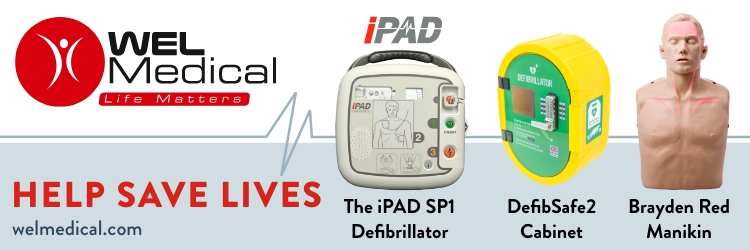
Jonathan Gilbrook
Managing Director, WEL Medical
A defibrillator is lifesaving equipment that gives an electric shock to the heart of someone experiencing ventricular fibrillation so that their natural pacemaker can reboot and restart in a normal rhythm.
Defibrillators will become increasingly common in workplace and home settings, says Jonathan Gilbrook, Managing Director of medical equipment firm, WEL Medical. Once, defibrillators could only be used by trained medical professionals, but technology now makes them simple to operate. Virtually anyone can use them to save a life.
How will the defibrillator market change in the next few years?
JG: In recent years, guideline changes regarding first aid in the workplace have seen defibrillators included in training courses. Plus, they’ve become increasingly visible in public locations. The Premier League have funded thousands of defibrillators, supplied free-of-charge to football clubs across the UK. Many of these have still not been claimed (visit premierleaguedefibs.org/ to claim one).
We believe that demand for defibrillators in workplaces will continue to grow. As technological improvements make defibrillators smaller and less expensive, the biggest change in the next five years could be their appearance in homes.
It’s reported that 80% of all out-of-hospital cardiac arrests happen in the home.
How are you responding to this increase in acceptance of defibrillators?
JG: People want modern technology, simplicity of operation and value for money, so we’re about to introduce a more cost-effective defibrillator aimed at the layperson and workplace. We also produce outdoor and indoor defibrillator storage cabinets which will soon be able to connect to the Internet of Things to allow people to remotely see that their defibrillator is being stored correctly and ready to save a life.
It’s reported that 80% of all out-of-hospital cardiac arrests happen in the home, so we’re working on a reasonable-cost defibrillator as part of our iPAD range for the domestic market. Our Brayden range of CPR (cardiopulmonary resuscitation) training manikins have been specifically designed to help laypersons understand and learn CPR.
What is being done to increase chances of survival for cardiac cases in the home?
JG: A challenge has been educating the public about defibrillators and CPR. We’ve been privileged to work with philanthropic and charitable organisations across the UK and Ireland that raise money to place defibrillators locally and provide CPR training.
In an emergency, people must know where defibrillators are located. The British Heart Foundation has a national database of public-access defibrillators — called The Circuit — linked to the Ambulance Services. If you’re responsible for a community defibrillator, or you have one in your workplace and are prepared to let the community use it, put it in an outdoor cabinet and register it with The Circuit (thecircuit.uk).




